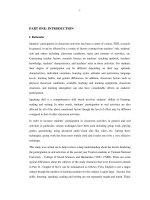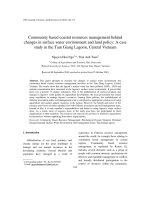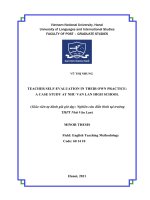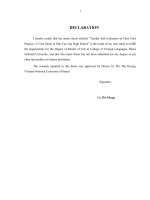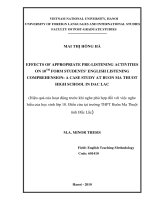Teacher and students’ factors affecting students’ participation in pair work and group work – A case study at Luong Van Tuy Gifted High School
Bạn đang xem bản rút gọn của tài liệu. Xem và tải ngay bản đầy đủ của tài liệu tại đây (469.15 KB, 16 trang )
Teacher and students’ factors affecting students’
participation in pair work and group work – A
case study at Luong Van Tuy Gifted High School
Phạm Tuyết Minh
Trường Đại học KHXH&NV
Luận văn ThS. Chuyên ngành: English Teaching Methodology; Mã số: 60 14 10
Người hướng dẫn: TS. Nguyễn Thu Lệ Hằng
Năm bảo vệ: 2011
Abstract: This thesis was carried out to investigate the application of pair work and
group work in speaking class, the human factors affecting students’ participation in pairs,
in groups and some feasible solutions to improve students’ participation in pair work and
in group work, as recommended by the teachers and students at Luong Van Tuy Gifted
High School in Ninh Binh. Survey questionnaires for teachers and students, class
observation and interviews were employed to answer the research questions. The findings
of the research revealed that pair work and group work were often implemented in
English speaking classes, especially in English major classes. Both students and teachers
there were well aware of the importance of pair work and group work. That why, when
being asked to work in groups and in pairs, some English major students showed the
enthusiasm and eagerness during the activities. However, there were some students who
seemed to hesitate and not to be ready to work, especially the weaker ones who did only a
little because of several factors including human factors, classroom factors and culture
obstacles. The lack of experience in organizing pair work and group work, the lack of
time for preparation, habits of old teaching methods and the uneven allocation of turn
were considered the main factors came from teacher that affected the students’
participation in pairs and in groups. The students’ passive learning habits, the fear of
making mistakes, the un – cooperation of partners and the overuse of mother tongue were
drawn to be the main factors came from students that had negatively affected to their
participation in pairs and in groups. In order to make pair work and group work more
successful, some practical recommendations for students and teachers were proposed,
too. It is hoped that this thesis will contribute to make pair work and group work
activities more successful in speaking class at Luong Van Tuy Gifted High School in
particular and at gifted high schools in general.
Keywords: Tiếng Anh; Hoạt động nhóm; Phương pháp giảng dạy
v
TABLE OF CONTENTS
Page
DECLARATION…………………………………………………………………………… i
ACKNOWLEDGEMENT…………………………………………………………………….ii
ABSTRACT ………………………………………………………………… …………….iii
LIST OF CHARTS……………………………………………………….…………… … iv
TABLE OF CONTENTS…………………………………………………………………… v
PART A: INTRODUCTION…………………………………………… ….………… 1
I. Rationale of the study……….…………………………………… … … 1
II. Aims of the study ……………………………………………… ……….…….2
III. Scope of the study……………………………………………………… 2
IV. Research questions ………………………………………………………… 2
V. Methodology of the study……………………………………………… …… 3
VI. Significance of the study………………………………………………… … 3
VII. Design of the study…………………………………………………… …… 4
VIII. Summary………………………………………………………………… 5
PART B: DEVELOPMENT……………………………………………… ……… … 6
CHAPTER I: LITERATURE REVIEW ……………………………… …… ………6
I. Communicative Language Teaching (CLT) ……………………………….………… 6
I.1. An overview of Communicative Language Teaching………………… … ….6
I. 2. Communicative activities……………………………………………… …… 6
II. Classroom work arrangements: Pair work and Group work…………………………….7
II.1. Definition and description of Pair Work and Group Work………………… 7
II. 2. Advantages and disadvantages of Pair work and Group work……………… 7
II.3. Organization of Pair Work and Group Work………………………………….9
II. 3.1. Formation……………………………………………………… … 9
II. 3.2. Procedures for Pair Work and Group Work………………… …….9
II. 3.3. Seating arrangement in Pair Work and Group Work…………… 10
vi
III. Students’ participation and factors affecting their participation in Pair Work and Group
work…………………………………………………………………………… …………10
III.1. Concept of students’ participation in PW and GW…… ………………… 10
III. 2. Human factors affecting their participation in Pair work and Group
work……………………………………………………………………………………… 11
III. 2.1. Students’ factors……………………………………… ……………… 11
III. 2.1.1. Students’ learning style…………………………….………… 11
III. 2.1.2. Students’ attitude and motivation………………….……………11
III. 2.1.3. Students’ language level……………………… ………………11
III. 2.1.4. Students’ learning habit…………………………………………12
III. 2.1.5. Gender difference…………………………….…………………12
III. 2.2. Teacher’s factors…………………………………………… ………… 13
III. 2.2.1. Teacher’s teaching methods………………………… ……… 13
III. 2.2.2. Teacher’s knowledge……………………………………………13
III. 2.2.3. Teacher’s characteristics……………………………… …… 13
III. 2.2.4. Teacher’s role in Pair work and Group work………………… 14
IV. Summary…………………………………… ……………………….……………….14
CHAPTER II: THE STUDY……………………………………………… ……………15
I. Introduction………………………………………………………………………… 15
II. English learning situation at Luong Van Tuy Gifted High School……… ………… 15
II.1. Students ……………………………………………………… …… …….15
II.2. Teachers………………………………………………… ………… ………16
II.3. Textbook………………………………………………………… ….…… 16
II.4. Using pair work and Group work in speaking lesson………….… …………16
III. Methodology and design of the study……………………………………… ………17
III.1. Subjects of the study……………………………………….…… …………17
III.2. Research questions……………………………………………… ……… 17
III.3. Research methods……….………………………………… … ……….…17
III.4. Research instruments: …………………………………………….…………18
III.4.1. Survey questionnaires …………………………………… …… 18
III.4.2. Class Observation …………………………………………… … 18
III.4.3. Interviews…………………………………… …………… ……18
III.5. Data collection procedures………………………………………… …… 19
III.6. Data analysis……………………………………………………… …… 21
vii
III.7. Summary…………………………………………… …… ………………19
CHAPTER III: PRESENTATION OF STATISICAL RESULTS……………………20
I. Introduction………………………………………………………………………… 21
II. Presentation of statistical results……………………………………………………… 21
1. How are PW and GW applied in English speaking class at Luong Van Tuy Gifted High
school? How do students participate in Pair work and group work? 21
2. What are the human factors affecting students’ participation in Pair work and Group
work? ………………………………………………………………………………… …26
3. What are the feasible solutions to improve students’ participation in pair work and in
group work, as recommended by the teachers and students? 32
CHAPTER IV: SUMMARY OF FINDINGS AND RECOMMENDATIONS ….….38
I. Findings: ………………………………………………………………………… ……38
I.1. Research question 1: How are Pair work and Group work used in speaking
lesson at Luong Van Tuy Gifted High School? How do students participate in Pair work
and group work? ………………………………………………………………………… 38
I.2. Research question 2: What are the human factors affecting students’
participation in Pair work and Group work? …………………………………………… 39
I.2.1. Teacher’s factors………………………………………… ……… 39
I.2.2. Students’ factors……………………………………………… ……39
I.3. Research question 3: What are the feasible solutions to improve students’
participation in pair work and in group work, as recommended by the teachers and
students? 40
II. Some main recommendations: …………………………………………………………41
II.1. To teachers……………………………………………………………………41
II.2. To students……………………………………………………………………42
PART C: CONCLUSION…………………………………………………… …………44
I. Conclusions …………………………………………………………… …………… 44
II. Limitation of the study …………………………………………………………………44
III. Suggestions for further studies ……………………………………………………… 44
PART D: REFERENCES………………………………………………… ……………46
1
PART A. INTRODUCTION
I. Rationale of the study
In recent decades, English has been more and more important in Vietnam. The
importance of English is not only in how many people speak it but also in what it is used
for. Besides the native language is popularly used in all fields of the society, English is
now widely known as the major language of intercommunication, international
commerce, business, science and technology and so on. As a result, there has been a
positive trend of teaching and learning English across the country. People, from children
to adults, learn English with different purposes. In general, despite deriving from
different purposes, every one wants to turn English to become their own instrument in
their lives.
Over the past few years, the application of the communicative language teaching
method has been widely adopted. This marked the beginning of a major change in the
language teaching and learning at Luong Van Tuy Gifted High School in Ninh Binh. And
the students’ speaking skill as well as their communicative abilities has been improved
remarkably. In the speaking class of English major students, there are many speaking
activities. Among them, Pair work and Group work, key features of learner – centered
orientation – have received more emphasis because of a number of advantages they bring
about.
Being a teacher of English at Luong Van Tuy Gifted High School, the researcher
is well aware of the importance of using pair work and group work during speaking
lesson. However, like many other teachers of English here, the researcher see that the
students in general and the English proficiency students have also faced many challenges
coming from teacher, students, classroom condition, and different culture between two
languages when organizing and managing pair work and group work. This lead me the
choice of the study “Teacher and students’ factors affecting students’ participation in
pair work and group work – A case study at Luong Van Tuy Gifted High School” with
the hope of investigating the teacher and students’ factors which come from teacher and
students themselves affecting the students’ participation in pair work and group work.
With regard to the factors affecting the students’ participation in pairs and in groups, the
study focused on the students’ factors including learning styles, attitudes and motivation,
2
language levels, learning habits and gender differences; teacher factors including teacher
methods, knowledge, characteristics and roles in oral activities. This research is also
aimed at discovering the application of pair work and group work during speaking lesson
in English major classes and then some feasible suggestions for both teacher and students
to organize the pair work and group work successfully. Thus, pair work and group work
can be used in flexible way to create variety, freshness in the classroom atmosphere and
most importantly, to enhance students’ oral practice of English.
II. Aims of the study
The aims of the study are to investigate the factors affecting students’
participation in pair work and group work of English major students at Luong Van Tuy
Gifted High School in Ninh Binh. Some mains purposes covering the study are
summarized as follows:
- To identify the application of pair work and group work in speaking lesson at
Luong Van Tuy Gifted High School.
- To point out some teacher and students’ factors affecting students’ participation
in pair work and group work.
- To give some suggestions for teachers to stimulate students and to improve their
participation when working in pairs and in groups.
III. Scope of the study
Concerning the scope of the study, some of the following things should be taken
into consideration. First, the subjects of the study are the 99 English major students at
Luong Van Tuy Gifted High School. We chose the major students of English because
they had basic knowledge about English and began to learn English as their proficiency
so in speaking lesson, they will be more participated in speaking activities, especially in
pair work and group work. Second, the study only focuses on oral activities because
speaking skill is considered the most important and needs developing for their future
employment aspect. Third, the study concentrates to find out the human factors including
teacher factors and student factors. Finally, the two techniques chosen to be investigated
are pair work and group work.
IV. Research questions of the study
3
This study was aimed to answer the three following research questions:
1. How often are pair work and group work applied in English speaking class in
Luong Van Tuy Gifted High School? How actively are the students involved in pair work
and group work?
2. Which are the teacher and students’ factors affecting their participation in pair
work and group work?
3. What are the feasible solutions to improve students’ participation in pair work
and in group work, as recommended by the teachers and students?
V. Methodology of the study
To realize the aims of the study, a case study was used. The theoretical
background of the study comes from many published books written by different authors
on language teaching and language acquisition. The data collected for the study come
from two sources: The students and the teachers of English at Luong Van Tuy Gifted
High School (99 students of three English proficiency classes and 10 teachers of English)
by making survey questionnaires, class observation and interview. In this research,
quantitative method is used, too. All comments, remarks, recommendations assumption
and conclusion provided in the study based on the analysis of the statistics from the
survey questionnaires conducted with students and teachers of Luong Van Tuy Gifted
High School. The study is also based on a qualitative method with the author’s own
experience and observation during 6 years of teaching English.
VI. Significance of the study
The study is of great values by the following reasons:
First, the information about the self – evaluation of the participation in pair work
and group work of the students is believed to be useful for the teachers of English in
general and teachers of English at Luong Van Tuy Gifted High School in Ninh Binh in
particular.
Second, identifying some human factors affecting students’ participation of
students in pairs and in groups, pointing out students’ preferences and demands to
activities and techniques applied by teachers are believed to be helpful for all teachers
when teaching speaking and when designing pairs and groups.
4
Third, giving some recommendations for teachers to motivate students to
participate in pairs and groups and to overcome obstacles and difficulties in teaching
speaking is expected to be beneficial.
VII. Design of the study
The study is divided into four parts: The Introduction, the Development, the
Conclusion and the References.
Part A: Introduction
This part deals with the rationale, aims, scope, methods, significance and design
of the study.
Part B: Development
This part consists of the following chapters:
Chapter I: Literature review – is intended to give some theoretical background
related to Communicative language teaching, speaking skills and its related concepts,
classroom work arrangement (pair work and group work) and the concept of students’
participation in pairs and in groups and factors affecting students’ participation in pair
work and group work including students’ factors.
Chapter II: The study – presents the situation analysis, participants, data
collection instruments, data collection procedures and data analysis. The detailed results
of the survey and a comprehensive analysis on the data collected are focused.
Chapter III: Presentation of statistical results – analyzes the statistical results
from questionnaires, class observation and interviews which aim at answering three
research questions mentioned in the previous part.
Chapter IV: Summary of findings and recommendations – shows major findings
and offers some feasible solutions to improve students’ participation in pair work and in
group work, as recommended by the teachers and students.
Part C: Conclusion: - gives the conclusion from the results of the findings, some
suggestions for further researches and limitation of the study.
5
Part D: References: - provides readers a list of the lecturers, their books, the
publisher, the year of published, and pages that the author used as recommended
documents.
PART B: DEVELOPMENT
CHAPTER I - LITERATURE REVIEW
This chapter briefly covers the theories related to the study: Communicative
approach to language teaching, pair work and group work arrangement in language
teaching and learning and human factors affecting the students’ participation in pair work
and in group work.
I. COMMUNICATIVE LANGUAGE TEACHING (CLT)
I.1. AN OVERVIEW OF CLT
I.2. COMMUNICATIVE ACTIVITIES
II. CLASSROOM ARRANGEMENT: PAIR WORK AND GROUP WORK
II.1. Definition and description of Pair work and Group work
II.1.1. Pair work
II.1.2. Group work:
II.2. Advantages and disadvantages of pair work and group work:
II.2.1. Pair work:
II.2.2. Group work:
II.3. Organization of pair work and group work
II.3.1. Formation:
II.3.2. Procedures for Pair work and Group work:
II.3.3. Seating arrangement in pair work and group work:
III. Students’ participation and factors affecting their participation in Pair
work and Group work
III. 1. Concept of students’ participation in pair work and group work:
III.2. Human factors affecting students’ participation in Pair work and
Group work:
III.2.1. Students’ factors:
III.2.1.1. Students’ learning styles:
6
III.2.1.2. Students’ attitudes and motivation:
III.2.1.3. Students’ language levels:
III.2.1.4. Students’ learning habits:
III.2.1.5. Gender differences:
III.2.2. Teacher’s factors:
III.2.2.1. Teacher’s teaching methods:
III.2.2.2. Teachers’ knowledge:
III.2.2.3. Teachers’ characteristics:
III.2.2.4. Teachers’ roles in PW and GW:
IV. Summary
This chapter covered the theories related to CLT, classroom work arrangements
including pair work and group work, students’ participation concept and the human
factors affecting the students’ participation in pair work and in group work in detail.
Students’ participation can be affected by teachers’ factors and students’ ones including
teaching methods, teachers’ knowledge, teachers’ characteristics, and teachers’ roles in
classroom activities, the students’ passive learning habits, the fear of making mistakes of
students, the un – cooperation of partners and the overuse of mother tongue of students.
The chapter that follows will present all the information concerning the study: the
English learning situation at Luong Van Tuy Gifted High School including the teachers,
the students, the textbook and the using of pair work and group work in the speaking
lesson, the methodology of the study, the research questions, the research instruments and
the data collection procedures.
Chapter II – The study
I. Introduction
II. English learning situation at Luong Van Tuy Gifted High School
II.1. Students:
II.2. Teachers:
II.3. Textbook:
II.4. Using pair work and group work in speaking lesson:
III. Methodology and design of the study:
7
III.1. Subjects of the study:
The subjects of the study are 99 students of the three English major classes:
10,11,12 and 10 teachers of English at Luong Van Tuy Gifted High School.
III.2. Research methods:
To realize the aims of the study, a case study was used including the qualitative
and quantitative methods.
III.4. Research instruments:
III.4.1. Questionnaire survey:
The instrument used in this study consisted of two types of questionnaires: One
for teachers and the other for the students. Each of them has four parts. All the questions
are closed to avoid time – consuming of students when taking part in the survey.
III.4.2. Class Observation:
Before observing classes, the researcher has to design the classroom observations
sheet. The classes observed from grade 10 to 12 and with all ten teachers of English must
not be prepared especially for being observed.
III.4.3. Interviews:
The interview was carried out in Vietnamese. 9 students of 3 English major
classes and 3 teachers were randomly selected for the interview. The questions in the
interview were basically based on those in the questionnaires, but they were extended to
cover more open – ended questions to get through understanding of the reasons behind
each choice. Each conversation lasted for 5 to 7 minutes.
III.5. Data collection procedures
* Questionnaire survey:
* Class observation:
* Interviews:
III.6. Data analysis
Data analysis is not simply a single description of the collected data. In fact, it is
the process by which the researcher interprets the data collection from the survey
questionnaires, the class observation and interviews.
III.7. Summary
Chapter III - Presentation of statistical results
I. Introduction
8
II. Presentation of statistical results
CHAPTER IV- SUMMARY OF FINDINGS AND RECOMMENDATIONS
I. Findings from interviews, questionnaires and class observation:
1. To answer the first research question “How often are pair work and group
work applied in English speaking class at Luong Van Tuy Gifted High School in Ninh
Binh?” and “How actively are the students involved in pair work and group work?”,
The pair work and group work activities were often used in English speaking lesson and
the students of three English major classes took part in these activities of high proportion.
Students had positive view of the using of pair work and group work, so when they were
asked to work in pairs and in groups, they worked with great interest.
2. To answer the second research question “Which are the teacher and students’
factors affecting the students’ participation in pair work and group work?”, the teacher
and students’ factors had both positively and negatively affected to the students’
participation in pairs and in groups: The factors from teachers include the lack of
knowledge of pair work and group work, habits of old teaching methods, and not very
good preparation and the factors from students include the passive learning style, the
students’ fear of making mistakes and gender differences.
3. To answer the third research question “What are the feasible solutions to
improve students’ participation in pair work and in group work, as recommended by
the teachers and students?” all the students interviewed wanted their teachers to provide
them some more English structures, vocabulary, and suggested ideas concerning to the
topic to help them speak out in English accurately and fluently. They also wanted their
teacher to create an interesting lead – in, a competitive atmosphere and to give them
supports when necessary.
II. Some main recommendations:
II.1. To teachers:
First, to organize courses about the techniques especially the pair work and the
group work is considered the most important for every teacher.
9
Second, within the English group should organize professional meetings to
exchange teaching and material selecting experience. The teachers can attend the other’s
lectures to have more experience or to help others to improve the teaching quality.
Third, the teachers should enhance their extrinsic motivation by changing the
current assessment system with a view to increasing their participation in classroom
speaking activities.
Another issue that may reduce the effectiveness of pair work and group work is
the students’ Vietnamese use. The best way to keep students speaking English is that the
teachers should try their best to put an eye on all groups, pairs, and remind them and
model them the language use.
II.2. To students:
The students should participate in pair and group positively with the highest
motivation. They should become active speakers in the speaking class. Students should
be confident when working in pairs or in groups.
Besides this, the students should plan to form a habit of using English. This habit
should be built right from the beginning of the first lesson. They should make use of the
different sources such as newspaper, Internet… to be acquainted to the native speakers’
voice which helps to improve their pronunciation ability.
Moreover, they also should cooperate with friends and teachers. It is advisable
that the students should find more opportunities to practice speaking English by attending
English speaking clubs or by speaking English with foreigners.
PART C: CONCLUSION
I. Conclusions:
The findings analyzed in the previous chapter lead us to the following
conclusions:
The Pair work and group work are often applied in English speaking class at
Luong Van Tuy Gifted High School in Ninh Binh.
The two human factors affecting students’ participation in pair work and group
work are coming from teacher and students themselves. These factors have both
negatively and positively to students’ participation in Pair work and Group work as listed
10
here: The lack of knowledge, of time when organizing pair work and group work, the
habit of using traditional method during the speaking period for the old teacher and the
not very good preparation before and during the organizing pair work and group work,
the passive learning styles of the students including their pronunciation abilities, the fear
of making mistakes and gender differences and the overuse of the mother tongue when
taking p art in p airs and groups, too.
Thus, to stimulate the students’ participation in Pair work and Group work,
teachers should pay attention to these factors so that he/ she can make use of the
advantages of Pair work and Group work when organizing these two activities during
speaking class.
II. Limitation of the study
However, there is an obvious limitation that this length of time is not enough for
the students to familiarize themselves with learning. Neither is it long enough to measure
the effectiveness of a new idea in teaching language. As it can be seen from the students
and teacher questionnaires, the information to be obtained was quite limited and not very
accurate. Their response may be just their belief or thoughts that they have about their use
of working in pair and in group. Some students can answer things that they actually not
do or they have different understanding of some concepts/ terms used in the
questionnaire.
III. Suggestions for further studies
Some further research should be taken as follow:
- A study of the ways to use material provided by the textbook effectively in
organizing pair and group work.
- A study on the tips and techniques, which help to organize successfully pair
work and group work in crowded classes.
- A study on classroom conditions affecting students’ participation in PW and
GW.
- A study on cultural obstacles affecting students’ motivation in English speaking.
46
Part D: References
1. Barry K. (1993). Group Work Management. London.
2. Brown H.D. (1994). Teaching by Principles: An Interactive Approach to
Language Pedagory. London: Prentice Hall Regents.
3. Bryrne D. (1983). Teaching Oral English.London: Longman.
4. Downs, M. (2000). Increasing Students Motivation. Teacher’ Edition 4.
5. Doff A. (1988). Teaching English: A training course for Teachers. Cambridge
University Press.
6. Ellis R. (1994). The study of the Second Language Course for Teachers,
Cambridge University Press.
7. Harmer J. (1991). The Practice English Language Teaching. Longman.
8. Harmer J. (1999). The Practice of ELT. Longman.
9. Honey Field J. (1991). The Formation of Small Groups in the Language
Classroom. Guiderlines – A Periodical for Classroom Language teachers. Vol.13 No 1
June 1991, SEMEO Regional Language Center.
10. Larsen Freeman D.M. (1986). Techniques and Principles on Language
Teaching. Oxford University Press.
11. Little Wood W. (1981). Communicartive Language Teaching.Great Britain/
Cambridge University Press.
12. Nunan D. (1989). Designing Tasks for the Communicative Classroom. Great
Britain: Cambridge University Press.
13. Penny Ur (1996). A course in language teaching. Cambridge University Press.
Using groups in teaching and learning. Retrieved from the World Wide Web:
14. Stern H.H. (1983). Fundamental Concepts of Language Learning. Oxford:
Oxford Universities Press.
15. Skim Grek, Ngoh. (1991). Small group work in the Classroom, Guidelines.
Vol.14 No3.
16. Richard J.C and Roger T.S (1986). Approches to Methods in Language
Teaching. Cambridge University Press.
47
17. Underwood, M. (1987). Effective Class Management: A Practical Approach.
New York: Longman.

